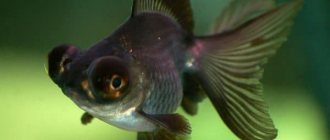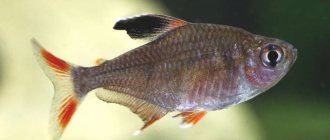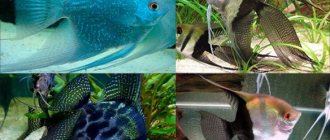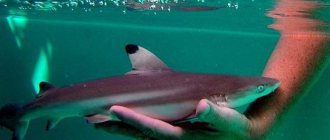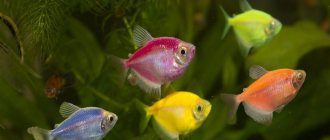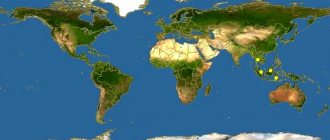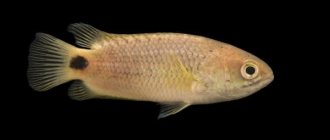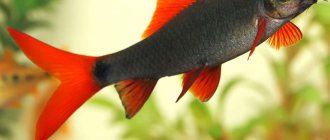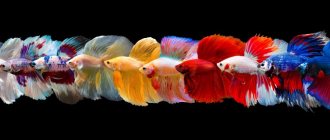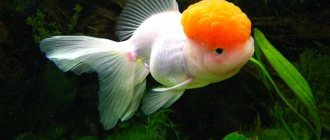Chindongo Demasoni (new name, 2016) Pseudotropheus Demasoni (old name, 1994)
It is a relatively new species of cichlids and belongs to the so-called Mbuna group. The species was discovered by Andreas Spreinath in 1993 and described the following year by Ed Konings and placed in the genus Pseudotropheus, named after his good friend Life Demasoni.
Synonyms
Russian: Cichlid Demasoni, Demasoni, Pseudotropheus Demasoni, Latin: Pseudotropheus demasoni,
Family: Cichlidae Genus: Chindongo Shan Li, Konings and Stauffer, 2021.
Range and Habitat
Africa: Endemic to Lake Malawi in Tanzania. The deposit of this fish is limited to a small area - the rocky reefs of Pombo and Cape Ndumbi south of the Ruhuhu River delta.
It lives in shallow water up to 4 meters around the tops of rocks, where it spends most of its time feeding on the algae that cover the rocks. Rarely seen in open water.
Description
The body pattern consists of clear alternating stripes of dark blue (almost black) and light blue. On the dorsal fin there are stripes sloping backwards, the lighter ones being thinner than the darker ones. Also, the blue-black caudal fin has numerous light blue rays. The upper and lower fins, as well as the tail fins, have a light blue edging.
Young immature individuals have a color pattern identical to the adult.
Size:
This is the smallest species of mbuna in the lake. In the natural environment, its adult size reaches 5 cm; in an aquarium it rarely exceeds 8 cm.
General information
The ray-finned fish pseudotropheus Demasoni (lat. pseudotropheus demasoni) belongs to the family of dwarf cichlids. It was first described by Ed Konings, a cichlid expert, in 1994. After which it was included in the list of ornamental aquarium fish.
Demasoni are very active, curious inhabitants of the reservoir. In their natural environment they feed on algae, small vertebrates and insects.
A distinctive feature is the dark blue color of the body in combination with transverse stripes. In aquariums, the average lifespan is 10 years.
Appearance
The fish have an elongated torpedo-shaped body, which reaches a length of up to 6-8 cm. The muzzle is rounded, the lower jaw is pushed forward relative to the upper.
The color is dominated by 2 colors - blue and light blue. 6 vertical stripes of dark blue alternate with 5 light blue. On the head, 3 azure rows are combined with 2 blue ones. The dorsal and caudal fins are also decorated with longitudinal markings. The anal and ventral fins are black. The color of an individual that has experienced stress becomes paler than that of its relatives.
Demasoni cichlid species
The rear parts of all fins, except for the soft front ones, have spiny, needle-shaped processes for protection from attack. The caudal fin has a trapezoidal shape.
For your information! Demasoni have only 1 nasal opening. Water entering the nostril is retained for a short time to recognize “odors.”
Habitat
In nature, the species lives in the rocky part of the freshwater African Lake Malawi. Also found near the coastline of Tanzania, near the Pombo Rocks.
Behavior and Compatibility
They are a species that incubates eggs in the mouth. Females take care of all the offspring. Males are clearly territorial and aggressive, defending their territory from other males as well as larger fish.
Males prefer to be surrounded by several females, while females prefer to stay in shelters that are protected by the dominant male, he spends most of his time swimming around these shelters that are in his territory.
In the wild, these fish are found in very large groups, swimming among rocky habitats. Surprisingly, members of these groups show little aggression towards each other. In order to successfully keep a group in an aquarium, it is recommended to create conditions close to natural ones.
One of the most aggressive and territorial mbuna.
Should not be kept with peaceful species, but can be combined with other mbunas of similar temperament. If they are kept in a mbuna community, the aquarium should be overpopulated to reduce aggression and the possibility of territory formation. They are not afraid and will attack fish several times their own size. Another option is to keep them in an overcrowded aquarium with only members of their own species. However, subdominant males can still be eliminated. There should be several females per male in order to reduce persecution. This in itself also creates problems, since, unlike many mbuna females, P. demasoni are intolerant of harassment.
An aquarium of any size should contain a minimum of twelve individuals of the species to disperse aggression. This not only keeps one male from being dominant over all others, but also helps females and subdominant males escape persecution to the point of exhaustion (and death), becoming “lost in the crowd.” A small group of 5 or 6 will not work as the dominant male will systematically kill every male tankmate until he is the only one left. The ratio of males to females doesn't matter when they are kept in large numbers, which is a bonus because accurately determining their sex can be a futile task for a dominant male.
If other fish species are to be kept in the same tank, they should be of different colors to minimize the risk of aggressive behavior.
Maintenance and care
The chameleon cichlid is an excellent aquarium fish for both experienced breeders and hobbyists with intermediate experience. These large aggressive cichlids are not suitable for keeping in a community aquarium with peaceful species, they should only be kept with other cichlids. Owners should be prepared to do regular water changes as chameleons are susceptible to bloat and other diseases that affect the fish due to poor care.
Pseudotropheus crabs eat a lot and are considered “dirty” fish. In the aquarium, they need good filtration and weekly partial water changes of 20-40%, depending on the biological load on the aquarium.
The water of Lake Malawi is highly alkaline due to its high mineralization, but at the same time it is distinguished by its purity and transparency, as well as the stability of its parameters. Therefore, it is very important to monitor water parameters with Lake Malawi cichlids. These fish require hard alkaline water, but not salty water. Salt, however, is sometimes used to increase carbonate hardness, and chameleons are quite salt tolerant. Allowed is 10% of the normal salinity of sea water, or a specific gravity of less than 1.0002.
One bumblebee cichlid needs a water volume of 190 liters. If these fish are kept with other compatible fish, a tank of at least 380 liters and at least 150 cm long is needed. The aquarium must have a strong, efficient filtration system and good water movement.
The bottom should be covered with fine or coarse gravel and there should also be plenty of rocks, with plenty of hiding places for non-dominant and brooding fish. To increase the pH level, crushed coral or aragonite sand is added. However, it must be remembered that at high pH, ammonia becomes fatal to fish, so regular water changes are required. Chameleon cichlids can also adapt to lower pH levels over time. The aquarium can include hardy, hard-water-friendly, fast-growing plants, such as many species of cryptocorynes.
Female
Requirements:
Aquarium volume : 189 liters; Temperature : 25.6 - 27.8 ° C; pH : 8.0-14.0; General hardness : 10 - 18 dGH;
Pseudotropheus crabro lives in the middle and lower parts of the aquarium.
Aquarium
Aquarium size 120 x 45 x 37.5 cm - 200 liters is the absolute minimum due to the aggressive nature of these fish. A large aquarium with plenty of caves and hiding places is ideal for them.
Rocky habitat is also of paramount importance. Unlike any other Mbuna, they spend a lot of time in caves and swim around rocks - not because they are shy, but because they are curious.
Create a network of caves and hiding places in your aquarium using piles of rocks. This species does not require much open space for swimming, preferring to stay close to rocky surfaces, so most of the aquarium should be designed this way. Sand is best suited as a soil.
Water parameters:
Temperature: 24 - 28° C pH: 7.6 - 8.8 Hardness: 10 - 25° dGH
It is important to constantly ensure that the high optical qualities of the water are maintained and to prevent silting of the soil, since even small doses of ammonia are dangerous for fish. The aquarium requires active filtration with aeration and weekly replacement of part of the water with fresh water.
Keeping in an aquarium
Pseudotropheus demasoni is not picky about living conditions. But, as with every fish, there are special rules for it, following which aquarists will ensure comfort and coziness for their animals.
Aquarium dimensions
It is recommended to place these cichlids in groups of 5-7 fish, where there will be only one male. They are susceptible to interspecific aggression, so the size of the territory plays an important role for them. The minimum volume of the aquarium should be 200 liters. When placing a larger number of individuals, you should choose a tank with a capacity of at least 300 liters.
Water parameters
The following water parameters are comfortable for Pseudotropheus demasoni:
- Temperature – 25 – 27°C;
- Acidity – 7.7 – 8.6 pH;
- Hardness – 12 – 20°.
Water changes should be carried out every week by 25% of the total volume of the aquarium.
Lighting
There are no special requirements for lighting, so special medium-power lamps and sunlight are suitable. But it is important that its rays scatter, otherwise the water will heat up.
Filtration and aeration
Filtration of the aquarium is mandatory, since in their natural environment fish live in clean water with moderate currents. A medium power filter is suitable for this task. Aeration must be strong.
Plants
Often, pseudotropheus demasoni begin to nibble on algae growing in the aquarium. Therefore, when choosing flora for a pond, you should choose plants with a strong root system. Good options would be:
- Cryptocoryne;
- Java fern;
- Arrowhead;
- Anubias;
- Water fern.
Priming
Under natural conditions, these cichlids live near stones. Therefore, gravel, various pebbles, crushed stone or coarse sand should be chosen as soil. In some parts of the bottom you can place 2-3 medium-sized stones.
Scenery
The presence of shelters is extremely important for Pseudotropheus demasoni. Therefore, the aquarium should contain a large number of caves, grottoes, “bays” or houses.
Nutrition
Herbivores in their natural habitat.
Accepts most of the offered feeds, but plant components in the form of spirulina flakes, blanched spinach, nori seaweed, etc. should form the majority of the diet. All this can be supplemented with live and frozen food, but in small quantities. Never feed meat to animals as this will harm the digestive system of these fish.
High quality cichlid mixtures, also suitable as a staple food.
Sexual Dimorphism
The fish is difficult to determine the sex of - they have absolutely no sexual dimorphism: males and females cannot be visually distinguished from each other, since both males and females have the same coloring and pattern.
However, mature males tend to be slightly larger. The male has egg-shaped spots on his anal fin, while females may have fewer. The best way to distinguish the sexes is by observing their behavior, as males are more territorial and aggressive than females. Obviously, only by comparing the size of the “genital papillae” can one unambiguously determine gender, but this method is for a person with experience.
Habitat and appearance
Pseudotropheus demasoni, in the photo, which can be seen below, is distinguished by its high activity and aggressive behavior. There are about twelve species of this fish. They get sick very rarely, because they have excellent health. They are often injured after fighting with each other. Pseudotropheus demasoni are very curious, making them interesting to watch.
This fish has a torpedo-shaped shape, which is very typical for cichlids of this species. The size of this fish is up to 700 mm. in length. To recognize the smell, these fish draw water into the nostril and hold it there for the required period of time. In this they are similar to sea fish.
As for the appearance of pseudotropheus demasoni, in the first 60 days it is quite difficult to distinguish a female from a male. The maximum lifespan of these fish is about 10 years.
Breeding
They are a species that incubates eggs in the mouth. For best results they should be kept in a species aquarium. Adult fish tend to be quite expensive, so a more viable option is to start with a group of 6-8 young fish. An aquarium measuring 100*40 cm is suitable and should be designed as suggested above. Offer some flat rocks and areas of open sand as potential spawning sites. The pH should be around 8.2-8.5 and the temperature 25-27°C.
The male will preen and then circle his chosen spawning site, displaying intense color to try to entice females to mate with him. It often pursues females that are not ready for spawning and can sometimes cause damage to them, and precisely in order to dispel aggression, it is better to keep the species in a harem - this does not allow the male to concentrate on one of the females. When she is ready, she will approach the spawning site and lay her eggs, after which she will take them into her mouth. The male has egg-shaped spots on his anal fin, which attracts the female. Then she presses herself against the male, who releases his milk directly into the female’s mouth, thereby fertilizing the eggs.
The female may carry her offspring of 5-30 eggs for 3-4 weeks before releasing the free-swimming fry.
She will not eat during this period and can be easily seen with her mouth swollen. If the female is overly stressed, she may prematurely spit out the brood or eat it, so care should be taken if you decide to move the fish to avoid eating the fry. It is also worth noting that if a female is away from her colony for too long, she may lose her position in the hierarchical order of that group. It is recommended to wait as long as possible before moving a female unless she is being harassed. To preserve the fry, you can place the female or themselves in a separate container. Some breeders artificially remove the fry from the mother's mouth at the 2 week stage and raise them from that point on as this usually results in more fry.
The fry are large enough to feed on brine shrimp nauplii from birth. They should be closely monitored as they grow, and separated as necessary, as they exhibit high levels of intraspecific aggression from a very early age.
Life expectancy is more than 5 years.
Reproduction and breeding
Representatives of the species breed in captivity only in large groups of 12 individuals.
Females spawn when they reach 2.5 cm in length. In this case, the number of offspring is small. During the spawning period, the dominant male changes color and shows maximum aggression; he can kill other males if the aquarium is small and there is not enough hiding space.
The male swims around the female, pressing her against the rocks in his territory. The female lays eggs, 5-15 eggs at a time, then collects them in her mouth. At this time, the boy protrudes his anal fin, which the girl mistakes for an egg and takes it into her mouth. The release of milk leads to fertilization. The eggs are incubated in the mouth for 7 days. The young hatch at a temperature of 27°C and swim freely without hiding for 2 weeks.
Female with eggs in her mouth
Juveniles start fights. The larger ones eat the smaller ones.
Adult residents are also capable of eating offspring. Newborn cichids are immediately moved to a separate tank.
Notes
Differences that distinguish the genus Chindongo from other mbuna genera in Lake Malawi are the possession of bicuspid teeth in the anterior portions of the outer rows of both the upper and lower jaws, a small mouth in which the lower jaw is slightly shorter than the upper jaw, and a pattern of vertical stripes on their sides during all stages of development.
Pseudotropheus minutus, a similar species to
Chindongo Demasoni, is sometimes confused with Pseudotropheus minutus, being similar in size and color. The differences are that in P. minutus the vertical lines stop before the caudal fin and are less distinct.
Introduction
Pseudotropheus Demasoni belongs to the cichlids of the Mbuna group; These are 12 varieties of very active and aggressive fish. Demasoni are sometimes confused with the yellow-finned pseudotropheus (Pseudotropheus minutus), which is similar in size and color, but they can be distinguished by the stripes that do not reach the caudal fin in Pseudotropheus minutus and are generally less pronounced, and the ability of males of Pseudotropheus demasoni to protect the egg laying. However, it should be remembered that many Mbuna were bred in captivity and you can only tell for sure which hybrid you have by purchasing fish from a reliable seller; You should also try not to cross cichlids of two or more varieties with each other.
